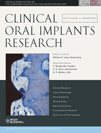Comparison of in vitro biocompatibility of NanoBone® and BioOss® for human osteoblasts
Abstract
Introduction: Scaffolds for bone tissue engineering seeded with the patient's own cells might be used as a preferable method to repair bone defects in the future. With the emerging new technologies of nanostructure design, new synthetic biomaterials are appearing on the market. Such scaffolds must be tested in vitro for their biocompatibility before clinical application. However, the choice between a natural or a synthetic biomaterial might be challenging for the doctor and the patient. In this study, we compared the biocompatibility of a synthetic bone substitute, NanoBone®, to the widely used natural bovine bone replacement material BioOss®.
Material and methods: The in vitro behaviour of human osteoblasts on both materials was investigated. Cell performance was determined using scanning electron microscopy (SEM), cell vitality staining and four biocompatibility tests (LDH, MTT, WST, BrdU).
Results: We found that both materials showed low cytotoxicity and good biocompatibility. The MTT proliferation test was superior for Nanobone®.
Discussion: Both scaffolds caused only little damage to human osteoblasts and justify their clinical application. However, NanoBone® was able to support and promote proliferation of human osteoblasts slightly better than BioOss® in our chosen test set-up. The results may guide doctors and patients when being challenged with the choice between a natural or a synthetic biomaterial. Further experiments are necessary to determine the comparison of biocompatibility in vivo.
To cite this article: Liu Q, Douglas T. Zamponi C, Becker ST, Sherry E, Sivananthan S, Warnke F, Wiltfang J, Warnke PH. Comparison of in vitro biocompatibility of NanoBone® and BioOss® for human osteoblasts.Clin. Oral Impl. Res22, 2011; 1259–1264.doi: 10.1111/j.1600-0501.2010.02100.x




